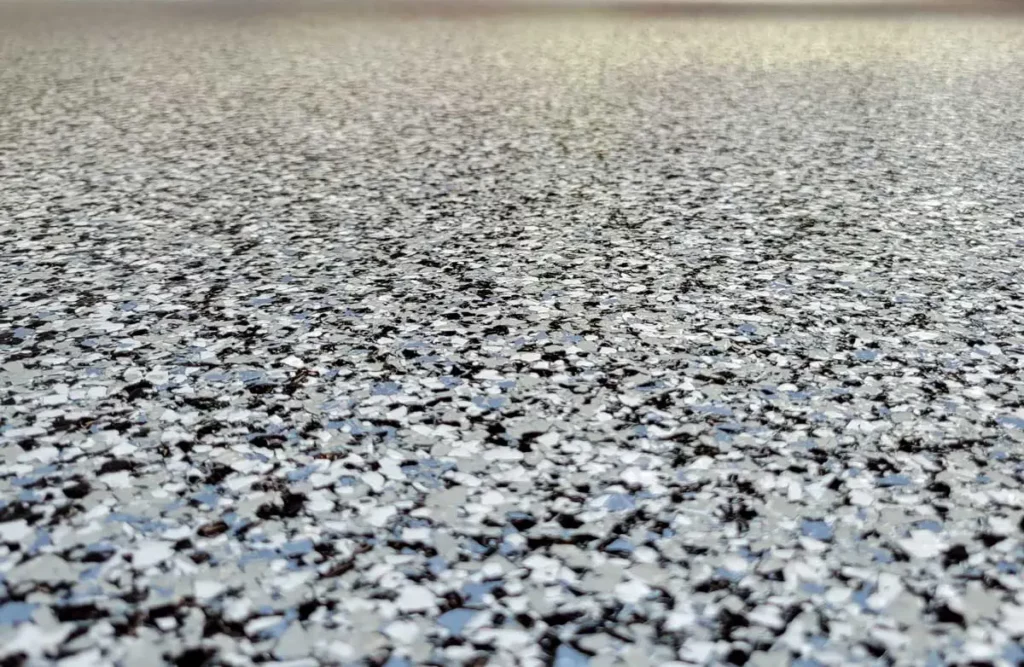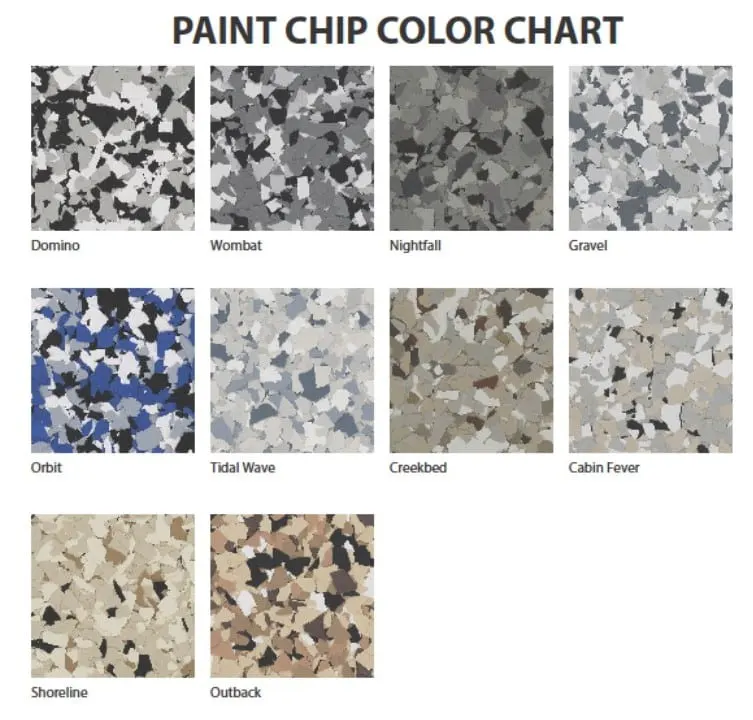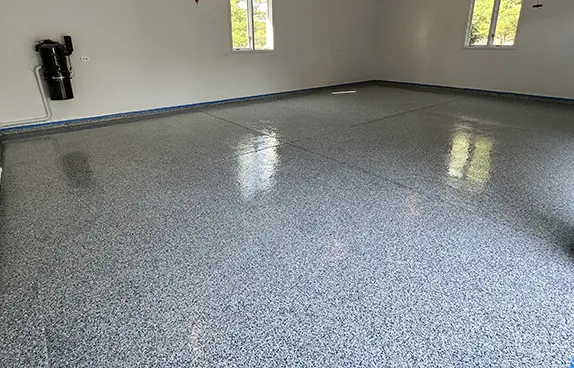A well-protected and aesthetically pleasing garage floor is a crucial aspect of any functional and visually appealing garage space. With a plethora of options available, choosing the right garage floor coating can be a daunting task. In this blog post, we will take a closer look at epoxy vs polyaspartic what is best for your garage floor – comparing their properties, applications, and benefits to help you make an informed decision for your garage floor.
Key Takeaways
Epoxy and polyaspartic coatings provide protection and aesthetics for garage floors, with epoxy being better suited for indoor use.
Epoxy offers customizable options but requires maintenance, while polyaspartic provides superior durability and UV resistance.
When choosing a coating consider budget, durability, environmental impact & other preferences to decide which is best for your garage floor.
Understanding Epoxy and Polyaspartic Coatings

Epoxy and polyaspartic coatings are the most commonly used garage floor coatings, both providing protection and decorative appeal for concrete garage floors, including the concrete floor itself. While epoxy coatings are resin polymers best suited for indoor use, polyaspartic coatings are a more modern, heat-resistant, and chemical-resistant alternative.
Let’s explore the properties, benefits, and drawbacks of both epoxy and polyaspartic coatings more closely.
Epoxy Coatings
Epoxy coatings are resin polymers that have been employed to safeguard concrete floors, particularly in garage flooring, for many years. Primers, color bases, and polyurethane are the essential components of an epoxy floor coating. Different layers of these compounds establish the look and long-lasting protection of epoxy floors.
Epoxy coatings are customizable, ideal for indoor use, and provide a protective layer for concrete garage flooring. However, they may be susceptible to chipping and fading with time.
Polyaspartic Coatings
Polyaspartic coatings are a newer invention, initially developed in the late 1990s for mitigating rust and corrosion on steel structures. They offer:
Enhanced durability
Flexibility
Resistance to wear and tear compared to epoxy coating
Excellent resistance to UV rays, ensuring they maintain their vivid colors for a long time.
When it comes to garage floors, polyaspartic coatings such as FloortexTM provide superior protection compared to most epoxy flooring systems.
Comparing Durability and Lifespan

Durability and lifespan are significant considerations when choosing a garage floor coating. While epoxy coatings are durable, they may be prone to cracking and fading over time. On the other hand, polyaspartic coatings offer enhanced durability, flexibility, and resistance to wear and tear.
We will now weigh up the durability and lifespan of these two widely-used garage floor coatings.
Epoxy Durability
Epoxy coatings are known for their durability and longevity, being highly resistant to:
chemicals
stains
cracks
scratches
With proper use and maintenance, epoxy coatings can last between 10 and 20 years.
However, they may be prone to cracking and fading over time due to factors such as UV exposure.
Polyaspartic Durability
Polyaspartic coatings offer superior durability, strength, and resilience to wear and tear compared to epoxy coatings. These coatings can last up to 20 years, providing protection against abrasion, chemicals, and UV radiation.
A professionally applied polyaspartic floor coating, such as Floortex™, can last up to a decade or more, outlasting many epoxy coatings.
Installation Process and Time

There are notable differences in the installation process and time requirements between epoxy and polyaspartic coatings. Epoxy installation is more conducive to a do-it-yourself approach, though it necessitates a longer curing time.
In contrast, polyaspartic installation is more time-efficient but usually requires professional assistance for successful implementation. We will now delve into the installation process and time requirements for each type of coating.
Epoxy Installation
Epoxy installation is relatively straightforward for DIY projects, although it does require a longer curing time. The application process generally involves a primer, a color base coat, and two surface coatings of polyurethane.
Epoxy coatings necessitate a minimum temperature of 50-55° F (10-13° C) for application and cannot be applied if temperatures exceed 85-90° F (29-32° C). It is essential to wear protective breathing gear, such as a respirator with an acid filter, when applying epoxy coating to a garage floor.
Polyaspartic Installation
Polyaspartic installation is advantageous due to its:
Rapid drying times
Low VOC emissions
Single-day installation process
Minimal unpleasant odors compared to epoxy coatings.
However, the quick drying nature of the coating does not provide much room for error, often necessitating professional assistance for successful implementation.
Polyaspartic coatings can be applied in a wide range of temperatures, making them more versatile for year-round installation.
Customization and Aesthetics

You can tailor both epoxy and polyaspartic garage floor coatings to fit your aesthetic tastes. Decorative flakes can be added to both types of coatings, providing an additional layer of texture and visual appeal.
Now, let’s look at the customization and aesthetic options available for epoxy and polyaspartic garage floor coatings.
Epoxy Customization
Epoxy coatings offer a wide range of color options and can be customized with vinyl flake coatings to suit your desired aesthetic. They provide a more comprehensive color palette than polyaspartic coatings, allowing you to create a unique and personalized look for your garage floor.
Polyaspartic Customization
While polyaspartic coatings have fewer color options than epoxy coatings, they still offer a range of colors, patterns, textures, and broadcast media for customization.
Polyaspartic coatings, such as Floortex™, provide a superior quality of decorative flakes, ensuring a long-lasting and stunning result for your garage floor with polyaspartic floor coatings.
Cost Comparison

Several factors, including the size of the area and the state of the concrete, can influence the costs of epoxy and polyaspartic coatings for garage floors. Epoxy coatings are typically more cost-effective than polyaspartic coatings, although they may require additional upkeep over time.
In contrast, polyaspartic coatings are pricier but provide enhanced durability and a longer lifespan. Let’s now compare the costs associated with epoxy and polyaspartic coatings for garage floors.
Epoxy Costs
Epoxy coatings are generally more affordable, with costs ranging from $4 to $7 per square foot. However, they may require more maintenance over time due to factors such as cracking and fading.
The affordability of epoxy coatings makes them an attractive option for those on a tight budget.
Polyaspartic Costs
Polyaspartic coatings are more expensive than epoxy coatings, with costs ranging from $6 to over $10.00 per square foot. However, their added durability and longevity may make the investment worthwhile.
Those who prioritize long-lasting protection and aesthetics may find polyaspartic coatings to be the better option, despite the higher initial cost.
Environmental Impact and Safety

Considering the environmental impact and safety aspects of each option is crucial when choosing a garage floor coating. Epoxy coatings may emit higher VOCs and have a stronger odor, potentially affecting air quality. On the other hand, polyaspartic coatings typically have lower VOCs and are less odorous, making them a safer choice for those who are more sensitive.
We’ll now assess the environmental impact and safety of epoxy and polyaspartic coatings.
Epoxy Environmental Impact
Epoxy coatings can have a detrimental environmental impact due to the emission of volatile organic compounds (VOCs). These VOCs contribute to air pollution and adversely affect air quality.
Additionally, epoxy resin is usually derived from petroleum products, which are known to be toxic to the environment. However, the extent of the environmental effects caused by epoxy resin is not fully understood.
Polyaspartic Environmental Impact
Polyaspartic coatings are known to have a lower environmental impact in comparison to other coatings, owing to their reduced VOC emissions and use of fewer hazardous materials.
With lower VOCs and reduced odor, polyaspartic coatings are a more suitable choice for those with heightened sensitivities and a greater concern for the environment.
Choosing the Right Coating for Your Garage Floor

The choice of the right coating for your garage floor hinges on considerations such as:
Budget
Durability
Aesthetics
Environmental impact
Epoxy coatings are more cost-effective, customizable, and well-suited for indoor use, but they may be prone to cracking and fading over time.
Polyaspartic coatings, on the other hand, offer enhanced durability, UV resistance, and a longer lifespan, but they are more expensive and have fewer color options.
When making your decision, consider the pros and cons of both epoxy and polyaspartic coatings, as well as your specific needs and preferences. If budget is a primary concern and customization is a priority, epoxy coatings may be the best choice. However, if durability, UV resistance, and a longer lifespan are more important factors, investing in a polyaspartic coating may be a wise decision.
Summary
In conclusion, both epoxy and polyaspartic coatings offer unique advantages for your garage floor. Epoxy coatings are more affordable and customizable, while polyaspartic coatings provide superior durability, UV resistance, and a longer lifespan. By considering factors such as budget, durability, aesthetics, and environmental concerns, you can make an informed decision and choose the perfect coating for your garage floor.
Frequently Asked Questions
Is polyaspartic really better than epoxy?
Polyaspartic coatings are much more tolerant of temperature and less affected by stress than epoxy, making them far more durable. They won’t chip, scratch or scuff, and can be installed year round, making them the superior choice for any garage. Polyaspartic coatings are the perfect solution for any garage, offering superior durability and temperature tolerance. They won’t chip, scratch or scuff, and can be installed year round, making them the ideal choice for
Is polyaspartic good for garage floor?
Polyaspartic flooring is ideal for garage floors, as it can be applied in a variety of weather and temperature conditions and is durable and stain- and scratch-resistant.
What are the main differences between epoxy and polyaspartic coatings?
Epoxy coatings are typically best suited for indoor applications, while polyaspartic coatings offer increased resistance to heat, chemicals, and UV light, resulting in improved durability and protection.
How long does it take for epoxy and polyaspartic coatings to cure?
Epoxy coatings take several days to dry and up to a month to cure, while polyaspartic coatings can be cured within one day.
Can I customize my garage floor coating with decorative flakes?
Yes, you can customize your garage floor coating with decorative flakes for added texture and aesthetics.


Comments
One response to “Epoxy vs Polyaspartic: Which Option is Best for Your Garage Floor?”
[…] Coatings: A newer type of coating, polyaspartic coatings, cure very quickly and are highly durable. They are becoming popular in commercial settings due to […]